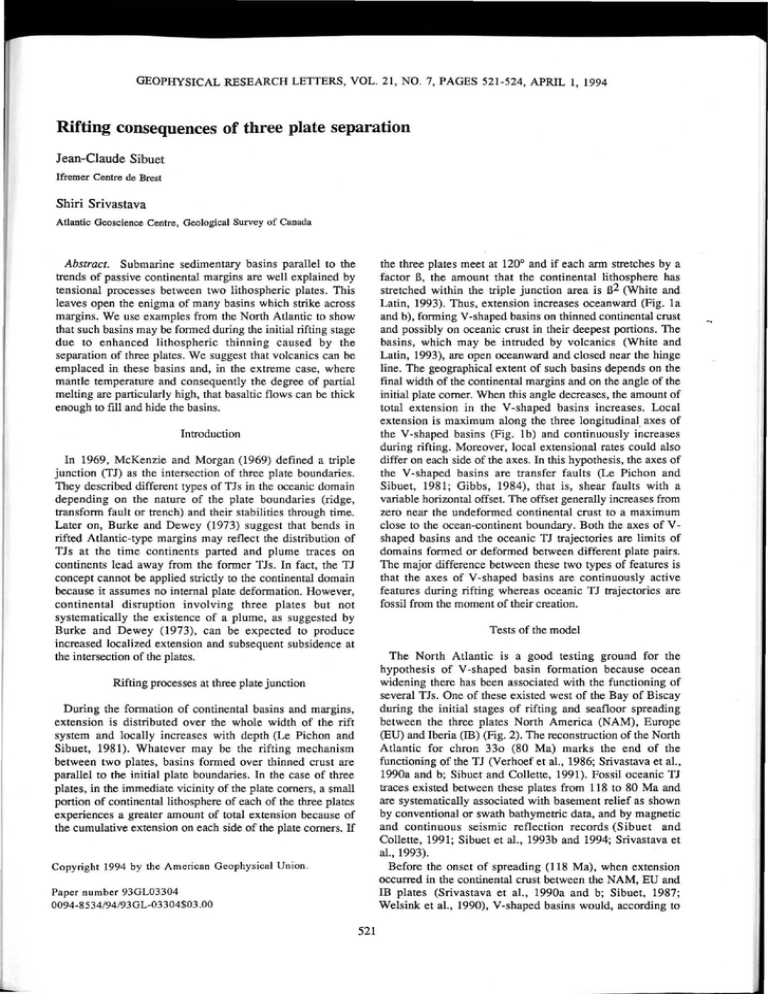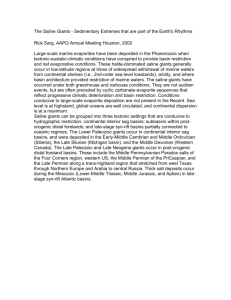Rifting consequences of three plate separation - Archimer
advertisement

GEOPHYSICAL RESEARCH LETIERS, VOL. 21 , NO. 7, PAGES 521-524, APRIL l, 1994 Rifting consequences of three plate separation Jean-Claude Sibuet Ifremer Centre de Brest Shiri Srivaslava Atlantic Geoscience Centre, Geological Survey of Canada the three plates meet at 120· and if each arm stretches by a Abstract. Submarine sedimentary basins parallel to the trends of passive continental margins are weil explained by tension al processes between two lithospheric plates. This leaves open the enigma of many basins which strike across margins. We use examples from the North Atlantic to show that such basins may be fonned during the initial rifting stage due to enhanced litho spheric thinning cau sed by the separation of three plates. We suggest that vo1canics can be emplaced in these ba sins and, in the extreme case, where mantle temperature and con sequently the degree of partial factor S, the amount that the continental lithosphere has stretched within the triple junction area is 8 2 (White and Latin, 1993). Thus, extension increases oceanward (Fig. la and h), fanning V-shaped basins on thinned continental crust and possibly on oceanic crust in their deepest portions. The basins, which may be intruded by volcanics (White and Latin, 1993), are open oceanward and closed near the hinge line. The geographical extent of such basins depends on the final width of the continental margins and on the angle of the initial plate corner. When this angle decreases, the amaunt of melting are parricularly high, that basaltic flows can he thick enough to fiU and hide the basins. total extension in the V-s haped basins increases . Local extension is maximum along the three longitudinal, axes of Introduction the Y-shaped basins (Fig. lb) and continuously increases ln 1969, McKenzie and Morgan (1969) defined a triple during rifting. Moreover, local extensional rates could also diffcr on cach side of the axes. ln this hypothesi s, the axes of the V- shaped basins are transfer faults (Le Pichon and junction (Tl) as the intersection of three plate boundaries. They described different types of Tls in the oceanic domain depending on the nature of the plate boundaries (ridge, tran sfonn fauIt or trench) and their stabilities through time. Sibuet, 1981 ; Gibbs, 1984), th at is, shear faults with a variable horiwntal offset. The offset generally increases from zero near the undeformed continental crust to a maximum close to the ocean-continent boundary. Both the axes of Vshaped basins and the oceanic TI trajectories are limits of domains fonned or deformed between different plate pairs. The major difference between these two types of features is that the axes of V-shaped basins are continuously active fealure s during rifting whereas oceank TI trajectories are fossil from the moment of their creation. Later on, Burke and Dewey (1973) suggest th at bends in rifted Atlantic-type margins may reflect the distribution of Tls at the time continents parted and plume traces on continents lead away from the former Tls. In fact, the Tl concept cannot be applied strictly to the continental domain because it assumes no internai plate defonnation. However, continental disruption involving three plates but not systematically the e xistence of a plume, as suggested by Tests of the model Burke and Dewey (1973), can be expected to produce increased localized exten sion and subsequent subsidence al The North Atlantic is a good testing ground for the the intersection of the plates. hypothesi s of V -shaped basin formation because ocean widening there has been associated with the functioning of Rifting processes at three plate junction several Tls . One of these existed west of the Bay of Biscay During the fonnation of continental basins and margins, extension is distributed over the whole width of the rift during the initial stages of rifting and seafloor spreading system and locaUy increases with depth (Le Pichon and Sibuet, 1981). Whatever may be the rifting mechanism between two plates, basins fonned over thinned cru st are (EU) and Iberia (lB) (Fig. 2). The reconstruction of the North between the three plates North America (NAM), Europe Atlantic for chron 330 (80 Ma) marks the end of the functioning of the Tl (Yerhoef et al., 1986; Srivastava et al., 1990a and b; Sibuet and Collette, 1991). Fossil oceanic Tl traces existed hetween these plates from 118 to 80 Ma and parallel to the initial plate boundaries. In the case of three plates, in the immediate vicinity of the plate corners, a small experiences a greater amount of total extension because of the cumulative extension on each side of the plate corners. li are systematically associated with basement relief as shown by conventional or swath bathymetric data, and by magnetic and continuous seismic reflection records (Sibuet and Copyright 1994 by the American Geophysîca! Union. Collette, 1991; Sibuet et al. , 1993b and 1994; Srivastava et al., 1993). Before the onset of spreading (118 Ma), when extension Paper number 93GL03304 occurred in the continental crust between the NAM, EU and lB plates (Srivastava et al. , 1990a and b; Sibuet, 1987; 0094 -8534/94 /930 L-03304$03 .00 Welsink et al., 1990), Y-shaped basins would, according to portion of continental lithosphere of each of the three plates 521 Sibuet and Srivastava: TInee Plate Separation 522 Interior basin is strietly confined to the portion of the a- Prerifl stage depression located between 70 and 140 km on profile OCI06 (Montadert et al., 1979, Fig. 3) though a broad depression exists between the Galicia bank and the Galicia shelf. Murillas et al. (1990) have shown that the initial subsidence began during the Triassie but, later on , during the Jurassic and early Cretaceous, the basin experienced several episodes of extension . However, the main rifting episode occurred lB during Valanginian and Aptian times (130 to 118 Ma). No b- End of rlfting stage volcanie intrusions have been reported in these two European basins . On the Flemish Cap margin, the ooly existing seismie profile was shot by the In stitute of Oceanographie Sciences. It shows the existence of a small bathymetric depression (km 65, lOS profile 294, Fig. 3) which is not evidenced on the bathymetric map (Fig. 3) mostly because bathymetric data are too scaree, but al so the presence of a sedimentary basin which appears very large because of the obliquity of the lB c- Drilling slage profile with respect to the orientation of the basin. Though the seismic profile parrallels the continental slope in its south western portion, we think that a V -shaped basin exists beneath the continental slope (Fig. 3) and is intruded by vokanies as confirmed by the 200 nT associated positive magnetic anomaly (Parson et al., 1985). We refer to this basin as the Erable basin (Sibuet et al., 1993a; Srivastava et al., 1993). As the continental margin is very narrow there, the Erable basin is short (70 km) compared with the more than 200 km long basins on the European side. Two of the three V-shaped basins, particularly the Interior 4 - 5 ··6 Fig. 1. Schematic diagram of the geographical distribution of extension between North America (NAM), Europe (EU) and Iberia (IB): a) before rifting, showing present-day continental crust (1) and continental crust which will be thinned during rifting (2), b) at the end of the rifting phase, showing the basin, do not begin precisely at the corner s of the undefonned pieces of continents and do not tenninate at the beginning of the oceanic fossil Tl trajectories (Fig. 2). It would not be expected that there is ideal coincidence of the fonnation of thinned continental crust between plates (3) and V-shaped basins (4) located on thinned continental crust and eventuali y on oceanic cru st in the vicinity of the TJ, c) during drifting stage, fass it Tl trajectories appear in the oceanic domain. A, Band C are conjugate points located al the oceancontinent boundary. Basins trend from close to plate corners across continental margins and are open oceanward. (5): ocean-continent boundary (OCB). (6): location of volcanics. QUf model, have formed on cach plate close to the initiation of the oceanic Tl (Fig. 2). A V-shaped basin, which we name here King Arthur Basin due to the close proximity of the tabular feature King Arthur Castle (Laughton et al., 1975), exists on the European side (Fig. 3). It is 100 km wide at the deep oceanic end and over 200 km long. Nothing has been '. 80 Ma f " ,. interpretation of 8 other existing seismie lines shot across the basin at different azimuths , confinn the existence of this V- Fig. 2. Reconstruction at chron 330 (80 Ma) relative to Europe (Sibuet and Collette, 1991). I-km bathymetric contour intervals From Lallemand and Sibuet (1986) and from the bathymetrie map east of Canada (Canadian Hydrographie Service, 1984). At the end of opening of the Bay of Biscay, the RRR triple junction was located at O. A, Band C are conjugate points (Sibuet and Collette, 1991) located at the shaped depression partially filled of sediments. There, synrift ocean-continent boundary. Thick continuous lines joining sediments are late Juras sic these points to 0 are the oceanic fossil Tl trajectories. Thick dashed lines are the axes of V-shaped basins (dotted areas) published about the origin of this basin. However, the lioe drawing of the MCS profile CMI3 (Fig. 3), as weil as the to early Albian age (Montadert et al., 1979). On the north-western Iberian margin, the Interior basin is of approximately the same size as the King Arthur basin (Fig. 3). Numerous MCS seismic profiles have been acquired and interpreted (e.g. Murillas et al. , 1990). The where local extension is maximum. Flow line s indicate the mean relative motion of plates since the onset of spreading. The location of the three insets of figure 3 is shown. Sibuet and Srivastava: TInee Plate Separation ® CD 49' King Arthur Basin k~,,- Vlb l'i'â\ l\\~( sw Q) r Interior Basin 1 1 NE King Arthur Basin il 523 ~' 'Pf::<:::r:5 ~f~: 10 .. - o W -- 5 ' S _ .... 50 ···s· _ ® Prome CM 13 5- ]00 1 150 km 10 E , "'''''"'"' '~'''' [~:,~::~?§;;iV::::~ o SW 50 ® 'f"';~:: ;;:<C prOl#ell)S 234 ~... • 100 NE Erable Basin .".. ry"";ijlif " Ilijlll~ 150 km .... ..A>-.'4' K ,--;r~'H, t~;~. ~~g km Fig. 3. Enlarged bathymetrie insets of the three V-shaped basins (dashed lines). Three signifieant MCS seismie profiles are located on the latest available bathymetrie maps from Sibuet et al. (1993b and 1994) and Lallemand and Sibuet (1986) for insets 1 and 2, from the Canadian Hydrographie Service (1984) for inset 3. Contour interval is 200 m and labels are every km. The seismic tine drawings show that the three basins are associated with a bathymetric depression. Note that the bathymetric map of the Erable Basin is not enough precise to display the depression. Dotted areas correspond 10 the prerift basement and vertical bars ta the volcanic feature whieh appears in the Erable basin. The intaerustal S refleetor is only seen on profile CM13. basin axes with Tl ttajectories, since initial rifting would take place preferentially where zones of weakness exist nearhy. Although there is no direct ev idence of the det ails of mechanical disruption in the thinned continental domain or of the synchronism of separation of plate pairs, extension between three plates during con ünental rifting offers a plausible general explanation for the formation of many sedimentary basins trending across continental margins. For example, the model prediets that the separation of the Rockall, Greenland and NAM plates would give rise to sueh basins at the south-western tip of Rockall (south west of the Edoras plateau; Roberts et al. , 1979) and south of Cape Farewell (gravity map; Srivastava et al., 1988). No third basin is expected on the NAM plate because of uninterrupted linearity of the margin at the Tl intersection. The Parana trap may be an extreme example of a major depression associated with initial V -shaped basins formed between three plates (Sibuet et al., 1984; Unternebr et al., 1988) in the continental dom ain. There, high mantle temperatures and consequent high degrees of partial melting have led ta the overflow and masking of the basins by flood basalts. Acknowledgments. We thank D. Masson and B. Whitmarsh who provided us copies of the Institute of Oceanographie Sciences seismie profile 294 shot on the Flemish Cap margin. Charlotte Keen, Dan MacKenzie, David Needham and Jap Verhoef offered very helpful suggestions and comments. References Burke, K. and J.F. Dewey, Plume generated triple junetions: key indieators in applying plate teetonies to old rocks, J. of Geology, 81, 406-433, 1973. 524 Sibuet and Srivastava: Three Plate Separation Canaman Hydrographie Service, General bathymetric chart of the oceans, 5.04 and 5.08, Ottawa, Canada, 1984. Gibbs, A.D., Structural evolution of extensional basin margins, J. Geol. Soc. London, 141, 609-620,1984. Lallemand S. and J.-C. Sibuet, Tectonic implications of canyon directions Qver the north-east Atlantic continental margins, Tectonics, 5,1125-1143,1986. Laughton A.S, D.G. Roberts and R. Graves, Bathymetry of the northeast Atlantic: Mid-Atlantic ridge to southwest Sibuet J.-c., S. Monti, J.-P. Réhault, C. Durand, E. Gueguen, and V. Louvel, Quantification de l'extension liée à la phase pyrénéenne et géométrie de la frontière de plaques dans la partie ouest du golfe de Gascogne, C. R. Acad. Sei. Paris, 317, 2,1207-1214, 1993b. Sibuet J.-c., S. Monti, and G. Pautot, Présentation d'une carte bathymérrique du golfe de Gascogne, C. R. Acad. Sei. Paris, 1994, in press. Stivastava S.P., D. Voppel and B. Tucholke, Geophysical Europe, Deep Sea Res., 22, 791-810,1975. Le Pichon X. and J.-C. Sibuet, Passive margins: a model of formation, J. Geophys. Res., 86, 3708-3720,1981. McKenzie D.P. and W.J. Morgan, Evolution of triple junctions, Nature, 224, 125-133, 1969. Montadert L., O. de Charpal, D. Roberts, P. Guennoc, and J.- 65° W, Deutsches Hydrographisches Institut, Hamburg, Nb 2302, 1988. Srivastava S.P., W.R. Roest, L.c. Kovacs, H. Schouten, K. Kligord, J. Verhoef and R. Macnab , Iberian plate C. Sibuet. Nonheast Atlantic passive margins: rifting and subsidence processes. l n Talwani M., Hay W.W., and and Africa, Nature, 344, 756-759, 1990a. Srivastava S.P., W.R. Roest, L.C. Kovacs, G. Oakey, S. Levesque, J. Verhoef and R. Macnab, Motion of lberia Ryan W.B.F. (eds), Deep Drilling results in the Atlantic Ocean: continental margins and paleoenvironment. M. Ewing Series 3, American Geophysical Union, Washington, 164-186, 1979. Murillas J., D. Mougenot, G. BoillOl, M.C. Comas, E. Banda and A . Mauffret, Structure and evolution of the Galicia Interior basin (Atlantic western lberian continental margin), Tectonophysics, 184, 297-319, 1990. Parson L.M., D.G. Masson, C.D. Pelton and A.C. Grant, Sei smic stratigraphy and structure of the east Canadian continental margin between 41 and 52°N, Canadian J. 0] Earth Sc., 22, 686-703,1985. Roberts D.G., L. Montadert and R.C. Searle, The western Rockall plateau: stratigraphy and structural evolution, ln Montadert L., Roberts D.G. et al., Init. Rep. of the Deep Sea Drill. l'roj., 48, U.S. Government Printing Office, Washington, 1061-1088, 1979. Sipuet J.-C., Contribution à l'étude des mécanismes de formation des marges continentales passives, Thèse de Doctorat d'Etat, Université de Bretagne Occidentale, Brest, 351 p., 1987. Sibuet J.-C. and B.J. Collette, Triple junctions of Bay of Biscay and North Atlantic: new constraints on the kinematic evolution, Geology, 19, 522-525,1991. Sibuet J.-C., W.W. Hay, A. Pronier, L. Montadert, K. Hinz and J. Fritsch, Early evolution of the South Atlantic: role of the rifting, ln Sibuet J .-C., Hay W.w. et al., Init. Rep. of the Deep Sea Drill. Proj., 75, U.S. Government Printing Office, Washington, 469-481,1984. Sibuet J.-c., S.P. Srivastava, M.-O. Beslier, K.C. Collin, J.-P. Le Formai, and V. Louvel, Multichannel seismic survey of passive margins around Flemish Cap (E Newfoundland): a French-Canadian collaborative program, Terra abstracrs, 5, 199, 1993a. atlas of the North Atlantic between 50° to 72° N and 0° to kinematics: a jumping plate boundary between Eurasia since the late Jurassic: results from detailed aeromagnetic measurements in the Newfoundland basin , Tectonophysics, 184,229-260, 1990b. Srivastava S.P., K. Collin, and J.-c. Sibuet, Multichannel sei smic survey in the Newfoundland Basin: a CanadianFrench collaboration, GAC-MAC joint annual meeting, Edmonton, Alberta, Canada, May 17-19, 1993, absrract, 1993. Unternehr P., D. Curie, J.-L. Olivet, J. Goslin and P. Beuzart, South Atlantic fits and intraplate boundaries in Africa and south America, Tectonophysics, 155,169-179, 1988. Verhoef 1., BJ. Collette, P.R. Miles, R.C. Searle, J.-c. Sibuet and C.A. William s. Magnetic anomalies in the north-cast Atlantic ocean, Mar. Geophys. Res., 8,1-25,1986. Wel s ink H.J ., S.P. Srivastava and A.J. Tankard, Basin architecture of the Newfoundland continental margin and ilS relationship to ocean crust fabric during extension, in Tankard A.J., Balkwill HR. (eds), Extensional tectonic and stratigraphy of the north Atlantic margins, Am . Assoc. Perroleum Geol. Mem., 46, Tulsa, 197- 213,1990. White N. and D. J. Latin, Subsidence analyses from the North Sea "triple junction", J . Geol. Soc. London, 150, 473-488, 1993. J.-C. Sibuet, Ifremer Centte de Brest, B.P. 70, 29280 Plouzané, France; internet: jcsibuet@ifremer.fr S. Srivastava, Atlantic Geoscience Centre, Geological Survey of Canada, P.O. Box 1006, Dartmouth, N.S., B2Y 4A2, Canada; internet: Srivasta@ agcrr.bio.ns.ca (Received June 7,1993; revised October 22, 1993; accepted November 22, 1993.)






